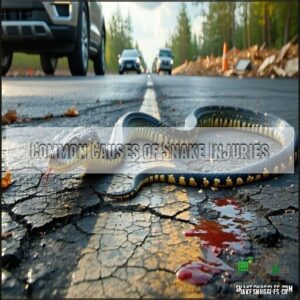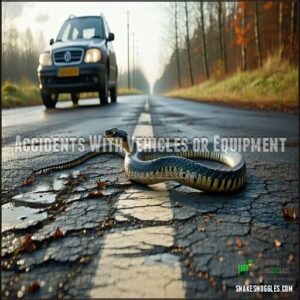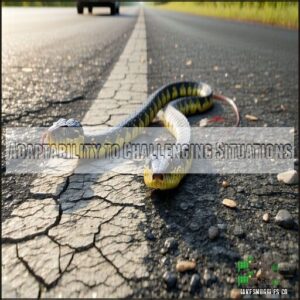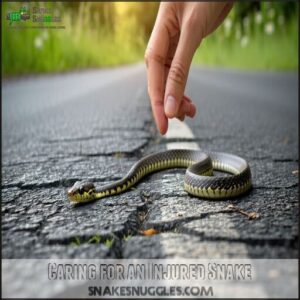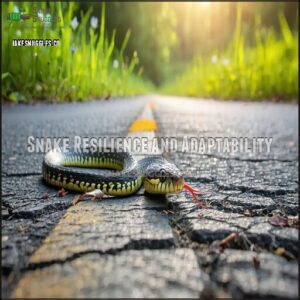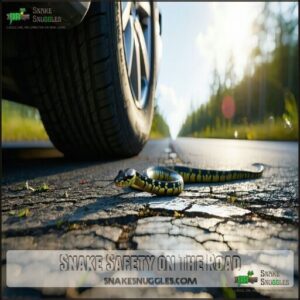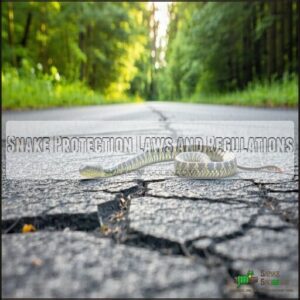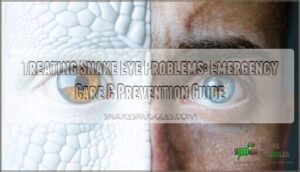This site is supported by our readers. We may earn a commission, at no cost to you, if you purchase through links.
 A snake can survive being run over, but it depends on several factors.
A snake can survive being run over, but it depends on several factors.
Its size, where it was hit, and the speed and weight of the vehicle all play a role. Smaller snakes or those hit near non-vital areas have better chances, while larger injuries often lead to internal damage or broken ribs.
Surprisingly, snakes’ slow metabolism and tough bodies help them survive injuries that might be fatal to other animals. However, survival doesn’t mean the snake is unharmed, as many suffer painful injuries or later fall victim to predators.
Curious about how snakes recover? There’s more to explore.
Table Of Contents
- Key Takeaways
- Can Snakes Survive Being Run Over?
- Snake Injuries and Roadkill Statistics
- Why Don’t Snakes Die Right Away?
- Factors Affecting a Snake’s Ability to Heal
- Caring for an Injured Snake
- Snake Resilience and Adaptability
- Snake Safety on The Road
- Rattlesnake Roadkill and Reporting
- Snake Protection Laws and Regulations
- Frequently Asked Questions (FAQs)
- Can a snake survive a run over?
- What happens if a snake is run over?
- Can a snake survive a car accident?
- Can a snake get into a car after a run over?
- Can a snake survive a hit?
- How many snakes survive a road accident?
- Can a snake live after being hit by a car?
- What happens when you run a snake over?
- Can a snake get in your car if you run over it?
- Will an injured snake survive?
- Conclusion
Key Takeaways
- Running over a snake often causes hidden internal injuries even if it appears to slither away, and survival rates are only 5-15%.
- Larger snakes have a better chance of surviving vehicle impacts due to their thicker bodies, but injuries like spinal damage or organ trauma are often fatal.
- Snakes’ slow metabolism and tough bodies help them endure and heal from severe injuries, but recovery can take months.
- Injured snakes are more vulnerable to infection and predators, and immediate help from a wildlife rehabilitator is critical for their survival.
Can Snakes Survive Being Run Over?
You’ll find that only about 5-15% of snakes survive being run over by vehicles, with many sustaining fatal internal injuries even when they appear unharmed.
Your chances of seeing a snake recover from such an incident depend on factors like the snake’s size, the type of ground surface, and whether essential organs were damaged during impact.
Survival Rates After Being Hit
Despite popular belief, snake survival rates after being run over are surprisingly low, ranging from just 5-15%. Many snakes that initially slither away will succumb to hidden internal injuries days or even months later, a phenomenon known as delayed mortality.
Snake survival rates after being run over are shockingly low—hidden injuries often lead to delayed mortality days or even months later.
Several factors determine whether a snake survives being hit:
- Impact Severity: Direct hits to critical organs are typically fatal, while glancing blows may cause less damage
- Species Variation: Larger species like carpet pythons have better chances due to their thicker bodies
- Ground Surface: Soft dirt or grass cushions impact better than hard pavement
Even when a snake appears uninjured, internal damage to organs and broken ribs often lead to eventual death. Snake resilience varies widely based on where they’re struck – hits north of the vent (mid-body) are almost always fatal, while impacts to the tail area may allow survival.
Factors Affecting Survival Chances
A snake’s chances of surviving a vehicle encounter depend on several key factors.
The impact severity and location determine survival odds—head strikes are typically fatal, while body impacts may allow recovery.
Species variation plays a pivotal role too, as larger snakes like pythons withstand trauma better due to their thicker bodies.
The ground surface underneath matters substantially; soft dirt cushions the blow compared to hard asphalt.
Snake size correlates directly with survival rates—larger species generally fare better than smaller ones when run over.
Injury location is critical—damage to essential organs drastically reduces snake survival chances.
The snake’s overall health before the incident also affects recovery potential.
durable.
impact.
Types of Injuries and Recovery Times
While vehicle impacts affect survival chances, the injuries themselves tell a more complete story.
When a snake gets run over, it faces several common trauma types, each with different recovery timelines:
- Spinal trauma can cripple a snake’s ability to move and hunt effectively
- Organ damage often remains hidden but can be deadly over time
- Fracture healing progresses slowly, taking 4-6 months due to their biology
- Infection risk increases as wounds heal at a much slower rate than mammals
- Metabolic impact slows both immune response and overall recovery
The severity of these injuries determines if recovery is possible.
A minor fracture might heal within a shed cycle or two, while severed spines need extensive care.
Even nonvenomous snakes like rat snakes recover faster than their venomous counterparts.
Remember that internal injuries may not be visible immediately, but they often lead to a gradual decline in the snake’s condition, which can be deadly over time due to the slow healing process and increased infection risk.
Snakes That Can Survive Being Run Over
When injuries occur, certain snakes have better chances of surviving vehicle encounters.
Larger species like pythons show impressive species resilience due to their substantial body mass and impact absorption capabilities.
You’ll find that survival depends heavily on where the vehicle strikes the snake and what lies beneath—soft ground and impacts away from essential organs improve injury tolerance substantially.
Though most victims eventually succumb to hidden internal damage, about 5-15% demonstrate remarkable snake survival rates.
Recovery factors include the snake’s health, species, and environment.
Their unique physiology enables some snake resilience, despite the devastating toll of snake roadkill nationwide.
Snake Injuries and Roadkill Statistics
You’ll find that snake injuries from vehicles affect thousands of reptiles yearly, with studies showing only 5-15% survival rates due to hidden internal damage.
Research from the University of Arizona identifies paved roads as a major threat to snake populations, with approximately 4,000 snakes killed along a single Arizona highway in just four years, highlighting the significant impact of vehicle collisions.
Common Causes of Snake Injuries
Moving beyond survival rates, let’s examine what causes snake injuries in the first place.
Vehicle impacts top the list of threats to snakes, with roadways cutting through natural habitats causing severe internal injuries and spinal damage. Construction hazards and agricultural activities also contribute substantially to snake roadkill statistics.
Cause Impact Common Injuries
When snakes encounter machinery or vehicles, their long bodies make them particularly vulnerable. The injury severity varies based on the snake’s size and the impact force. Many injuries aren’t immediately visible, as snakes may slither away with fatal internal damage that only becomes apparent later.
Predator Attacks
Predators pose a significant threat to snakes in the wild, creating constant survival challenges. When attacked, a snake’s defense mechanisms determine its fate.
Most snakes face predator vulnerability in open areas where escape routes are limited.
| Predator Type | Attack Strategy | Snake Defense Response |
|---|---|---|
| Birds of Prey | Aerial strikes | Playing dead, fleeing |
| Mammals | Biting, clawing | Musking, striking back |
| Reptiles | Ambush tactics | Camouflage, venom use |
Habitat influence directly affects survival rates, with forested areas offering better protection than open fields. Injury impact from predator encounters often leaves snakes weakened, making them vulnerable to secondary threats like vehicles or other predators.
Accidents With Vehicles or Equipment
While predators pose natural threats, human-related accidents remain the leading cause of snake injuries.
Vehicles and equipment present serious dangers to our slithering friends, with only 5-15% surviving after being run over.
| Vehicle Type | Impact Location | Snake Survival Rate |
|---|---|---|
| Cars/Trucks | Head/Mid-body | Very Low (0-5%) |
| Motorcycles | Any part | Low (5-10%) |
| Bicycles | Tail section | Moderate (10-15%) |
Road surface plays a vital role too – soft ground offers better chances than asphalt.
Snakes may enter vehicles seeking warmth and shelter.
Larger snake species like pythons typically survive better due to their thicker bodies.
Entrapment
Beyond vehicle impacts, snakes face life-threatening entrapment scenarios that often go unnoticed.
Wheel spoke entrapment occurs when snakes get caught in bicycle wheels, while undercarriage hiding leads to crushing injuries when vehicles move again.
Confined spaces pose serious risks to snakes seeking shelter.
Roadside debris creates escape challenges that can lead to fatal internal injuries or spinal damage.
| Entrapment Type | Risk Level | Common Location | Snake Survival Rate |
|---|---|---|---|
| Storm Drains | High | Urban Areas | 25% |
| Netting/Mesh | Very High | Construction Sites | 10% |
| Rock Crevices | Medium | Hiking Trails | 60% |
| Garbage Bins | High | Residential Areas | 35% |
Many snakes suffer crushing injuries when trying to navigate through tight spaces.
Their long bodies make backing out difficult, often resulting in panic that worsens their situation.
Snake injuries from entrapment can include damaged scales, broken ribs, and internal bleeding that aren’t immediately visible.
Snake Roadkill Statistics
Roadkill statistics reveal that about 85-95% of snakes die when hit by vehicles.
While many appear unharmed initially, internal injuries often cause delayed death.
Snake Roadkill Data Impact on Survival
Snake survival varies by impact type: direct hits (5-15% survival), tail strikes (20-30%), and glancing impacts (40-50%).
Studies show some drivers intentionally hit snake-like objects, further increasing mortality rates.
Why Don’t Snakes Die Right Away?
You might be surprised to see a snake slither away after being run over because their slow metabolism delays their response to serious injuries.
A snake’s slow metabolism allows it to endure serious injuries, slithering away seemingly unharmed while battling hidden internal damage.
Their bodies can function for days or even weeks with damaged organs or broken bones before showing signs of distress, which is a result of their slow metabolism.
Snakes’ Slow Metabolism and Survival
In the aftermath of vehicle impact, a snake’s slow metabolism becomes its greatest survival ally.
Unlike mammals, snakes operate on minimal energy, which extends their survival time after injuries.
- Energy Conservation: Their systems require less oxygen, allowing them to sustain essential functions despite trauma.
- Injury Tolerance: Snakes can endure damage that would kill most animals, surviving for weeks with broken bones.
- Delayed Mortality: Some snakes appear fine initially but succumb to internal injuries months later.
- Slow Recovery Process: Their healing timeline stretches longer, matching their metabolic rate.
- Resistance Mechanisms: Their biology offers unique protection against infection and shock.
This snake metabolism creates remarkable resilience, explaining why a run-over snake might slither away seemingly unharmed while battling unseen internal damage.
Their slow-motion healing process trades speed for endurance.
Anaerobic Metabolic Capacities
When snakes get run over, their anaerobic metabolic system activates to help them survive despite severe trauma.
This remarkable process generates energy without oxygen, allowing essential functions to continue.
The snake’s body basically switches to an emergency power mode, efficiently managing energy production while dealing with injuries – a key factor in their surprising resilience after vehicle impacts.
| Anaerobic Feature | Function | Survival Benefit |
|---|---|---|
| Lactate Production | Energy source | Powers cells when oxygen is limited |
| Reduced Metabolism | Conserves resources | Extends survival time post-injury |
| Oxygen Debt | Temporary compensation | Maintains critical organ function |
This metabolic backup system delays muscle fatigue and keeps essential processes running, which is crucial for the snake’s survival after severe injuries, and it plays a significant role in their ability to recover from such incidents.
Adaptability to Challenging Situations
Building on what we’ve discovered about snake metabolism, their adaptability to serious trauma is equally remarkable.
When faced with life-threatening situations like vehicle impacts, these creatures demonstrate surprising resilience. Their bodies can adapt to severe injuries through sensory compensation, allowing them to function even with damaged organs or senses.
A snake’s resourcefulness extends beyond simple survival mechanisms:
- Their organ redundancy lets them live despite internal bleeding that would kill most animals
- Many snakes continue hunting effectively even after significant trauma
- Their nervous system adapts to new limitations, showing they’re tougher than you think
Snake resilience and adaptability are most evident in their recovery patterns. After being run over, survivors often modify their movement patterns to compensate for spinal injuries. This disability adaptation happens naturally as the snake learns to use remaining functional body parts.
This remarkable ability to overcome serious injuries explains why these creatures sometimes slither away after seemingly fatal encounters – they’re simply built to endure and demonstrate surprising resilience in the face of adversity, making their recovery patterns a testament to their adaptability.
Factors Affecting a Snake’s Ability to Heal
You’ll find that a snake’s healing ability depends on several key factors including the type of injury, species, age, and overall health.
The snake’s chance of recovery is highest when the impact misses essential organs and when the reptile has access to proper conditions for its slow but remarkable healing process.
Type and Severity of Injury
The impact location on a snake’s body directly affects its chances of survival.
Not all injuries have the same outcome, with some allowing recovery while others prove fatal.
Injury Type Effect on Survival
Snake injuries vary in severity.
Crushing injuries to the head typically result in immediate death.
Spinal damage often leads to paralysis and eventual starvation.
Minor wounds might heal, but infection risk increases with time.
Internal injuries can cause slow decline even when external damage seems minimal.
Snake Species and Characteristics
After looking at injury types, let’s examine how a snake’s species plays a vital role in survival after vehicle impacts.
Not all snakes are created equal when facing tire trauma. Snake size matters substantially – larger species like pythons and boas have thicker bodies that provide natural armor against impacts. Their robust snake anatomy helps distribute force better than smaller species.
Snake physiology varies widely across species, affecting healing capabilities:
- Scale patterns differ between species, with thicker scales offering better protection
- Habitat variation creates different adaptations – desert dwellers often show greater resilience
- Diet diversity affects recovery speed, with well-nourished specimens healing faster
Snake species characteristics like venom potency can also play a surprising role, as some venomous species have antimicrobial properties that prevent infection after injury. This highlights the importance of understanding the specific species and its unique traits to better assess survival chances after a vehicle impact.
Age and Health of The Snake
A snake’s lifespan stage greatly impacts its survival chances after vehicle accidents.
Juveniles show higher vulnerability but faster healing due to their active metabolism. Adult resilience peaks when they’re well-nourished with strong immune systems. Seniors recover more slowly, especially with pre-existing conditions.
Factor Young Snake Adult Snake Senior Snake
Nutritional status directly affects injury severity outcomes – well-fed snakes heal better than malnourished ones.
Vulnerability to Predators
When severely injured from vehicle impacts, a snake’s vulnerability to predators increases dramatically.
Post-injury mobility limitations create a perfect storm for predation.
With compromised movement, snakes can’t utilize their natural defenses effectively.
Their camouflage effectiveness diminishes substantially when they can’t reposition themselves within their environment.
Behavioral changes occur immediately after injury, often preventing them from seeking proper shelter.
Snake survival rates plummet as hunting impairment leaves them unable to secure food while recovering.
Meanwhile, predator attraction increases as the injured snake may leak bodily fluids that signal weakness.
Common threats to injured snakes include:
- Birds of prey spotting unusual movement patterns
- Mammals detecting distress signals through scent
- Other reptiles sensing vulnerability through vibrations
- Scavengers following blood trails to find easy meals
- Domestic animals encountering defenseless snakes near roads
This predator vulnerability creates a dangerous situation where the initial vehicle injury isn’t what ultimately claims the snake’s life.
Caring for an Injured Snake
If you find an injured snake, you’ll need to contact a wildlife rehabilitator immediately as proper care requires specialized knowledge and equipment.
You shouldn’t attempt to handle the snake yourself as this can cause additional stress and injury to the animal and may put you at risk of a defensive bite.
Safely Capturing The Snake
After understanding how snakes heal, you’ll need to approach the injured reptile with caution.
Proper equipment is essential for safely capturing injured snakes.
Never use bare hands – instead, employ snake hooks or tongs to maintain distance.
To find the right tool, consider exploring a variety of snake handling equipment.
For containment methods, place a ventilated box nearby and gently guide the snake inside to minimize stress.
Remember, even injured snakes may strike defensively.
Venomous considerations are critical – always assume unknown species could be dangerous.
Once secured, keep the container in a quiet, dark place to reduce stress until animal rescue professionals arrive.
For snake first aid and handling techniques, contact wildlife rehabilitators immediately for expert assistance.
Housing Considerations
When setting up housing for an injured snake, proper conditions can mean the difference between life and death. Your temporary enclosure should provide security while supporting recovery from snake injuries.
Choose an appropriate setup with these essentials:
- Select a plastic container with secure, escape-proof lid that measures at least twice the snake’s length – injured snakes need space without excess room for movement
- Create a temperature gradient (75-85°F for most species) using a heat mat on one side to allow the snake to thermoregulate during recovery
- Maintain proper humidity levels (50-70% for most species) using a spray bottle and humidity gauge
For substrate choice, use paper towels or unprinted newspaper rather than loose materials that might stick to wounds. A good option is to find a quality reptile underpad for maintaining the temperature gradient. Include a shallow water dish and simple hide box for security. Keep the enclosure in a quiet location to reduce stress during snake recovery.
Wound Care
For proper wound care of an injured snake, cleanliness is the first defense against infection.
When treating snake injuries:
- Clean the wound using sterile saline solution or diluted povidone-iodine (1:10 ratio) to remove debris without damaging tissue.
- Apply a thin layer of reptile-safe antibiotic ointment to minor wounds, avoiding products with pain relievers.
- Keep the enclosure extra clean during recovery to prevent secondary infections.
Never wrap or bandage snake wounds as this prevents proper scale regeneration. Maintain ideal hydration by providing a clean water dish large enough for soaking.
Monitor for signs of internal injuries like unusual posture or breathing difficulties. Daily inspection helps track healing progress. Severely damaged scales will eventually shed, but complete recovery takes time.
Veterinary care remains essential for serious wounds, but you can also find specialized snake products to aid in the healing process, ensuring a proper recovery.
Supportive Therapies
Beyond cleaning wounds, your injured snake needs thorough supportive therapies for the best chance at recovery.
Fluid therapy keeps snakes hydrated after trauma – simply provide a clean water dish or, in severe cases, a vet may administer subcutaneous fluids.
Pain management is vital though snakes hide discomfort well. A vet can prescribe appropriate medications to reduce stress and aid healing.
Infection control means applying prescribed antibiotic ointments consistently as directed. Don’t use human products unless specifically recommended.
For nutritional support, offer smaller, easier-to-digest prey items once the snake shows interest in food again. Simple physical therapy involves gentle handling in a warm environment to maintain muscle tone.
Even injured snakes benefit from limited movement. Maintain proper temperatures and humidity levels to support your snake’s natural healing processes. Maintaining proper temperatures and humidity is key to creating healthy snake environments. The right environment acts like medicine for reptiles recovering from vehicle injuries.
Monitor progress daily and follow veterinary guidance closely.
Working With Wildlife Rehabilitators
For injured snakes with complex medical needs, wildlife rehabilitators are your best allies. These professionals have specialized species expertise for treating reptile trauma, including internal injuries that aren’t visible to untrained eyes.
When you find an injured snake, it’s crucial to act quickly.
- Contact a rehabilitator immediately – every minute counts for snake survival
- Describe the injury accurately, including what vehicle hit it
- Follow their transport instructions carefully to avoid additional trauma
- Ask about release criteria and typical recovery timelines
Rehabilitators follow established rehab protocols designed specifically for reptiles, which differ substantially from mammal care. They make difficult euthanasia decisions when injuries are too severe, saving snakes from prolonged suffering. Most centers also provide public education about preventing road injuries.
Remember that snake metabolism works slowly, so trauma recovery takes time. The right help can mean the difference between death and successful rehabilitation.
Snake Resilience and Adaptability
You’ll be surprised to learn that some snakes can survive being run over thanks to their unique physical adaptations and remarkable healing abilities.
Their flexible spines and slow metabolism allow them to withstand injuries that would kill most animals.
Though survival rates typically range from only 5-15% depending on the severity of impact and location of trauma.
Lost Senses
Losing a sense doesn’t mean losing all survival chances for a snake.
Their ability to adapt is remarkable. If a snake suffers vision impairment, it relies more on heat-sensing pits for thermal detection of prey. With olfactory loss, tongue flicking becomes more frequent to gather scent particles.
Even without hearing, snakes detect vibrations through their bodies, utilizing the ground as a sensory tool.
Balance problems from spinal damage can make hunting harder, but sensory compensation often helps snakes navigate obstacles. Their survival depends on adjusting behaviors to injury severity, sharpening remaining senses to stay alert.
Whether dealing with snake injuries and recovery or adapting to lost senses, snakes show impressive resilience in their environment.
Missing Body Parts
After losing sensory abilities, some snakes also survive with missing body parts. Unlike lizards, snakes can’t regrow tails, but they show remarkable adaptation to injuries.
When parts are missing, snakes adjust by:
- Compensating for tail loss with modified movement patterns
- Adapting to scale damage through specialized healing processes
- Surviving even with jaw damage by developing alternative feeding techniques
Despite severe injuries like spinal damage, many snakes continue to hunt and reproduce. Their streamlined bodies help them function even when missing sections that would disable other animals, demonstrating a unique ability to survive and thrive in challenging conditions.
Internal Organ Damage
Internal injuries, such as ruptured organs or internal bleeding, don’t always mean instant death for a snake.
Their slow metabolism often buys time, but untreated trauma can escalate into organ failure or infection. Injury severity and impact location matter most—head or spine blows usually lead to delayed mortality.
Here’s how the body copes:
| Factor | Effect | Outcome |
|---|---|---|
| Slow metabolism | Reduced bleeding risk | Prolonged survival |
| Ruptured organs | Functional loss | Potential organ failure |
| Internal bleeding | Hidden danger | Delayed mortality |
| Spinal cord damage | Movement loss | Decline over time |
| Infection risk | Compromised wounds | Increased mortality |
Ultimately, survival hinges on snake anatomy and the injury’s severity.
Snakes’ Ability to Adapt to Disabilities
A snake’s remarkable resilience allows it to adapt to disabilities after being run over.
These reptiles develop alternative survival methods when faced with physical limitations.
They use sensory compensation by relying more on heat detection or vibration sensing when vision is impaired.
Their adaptive hunting techniques change to match new mobility constraints, often focusing on ambush rather than pursuit.
You’ll find these animals conserve energy by limiting movement to smaller territories when injured.
Their slow metabolism actually helps with recovery, allowing gradual healing over time.
Many adjust their post-trauma behavior by seeking safer shelters and changing their active hours to avoid predators.
Providing physical enrichment options can further aid their recovery and well-being.
Their slow metabolism actually helps with recovery, allowing gradual healing over time.
Many adjust their post-trauma behavior by seeking safer shelters and changing their active hours to avoid predators.
- Watching a partially paralyzed snake still catch prey is truly humbling
- Their determination to survive despite missing body parts shows nature’s persistence
- Some snake recoveries seem almost miraculous given their injuries
- Their silent suffering and adaptation happens without complaint
- These mobility solutions evolve naturally without any external help
Snake Safety on The Road
You can help reduce snake roadkill by staying alert, especially in areas with wildlife. Snakes often move onto roads for warmth, making them more vulnerable to passing vehicles.
Avoiding Intentional Roadkill
Driving carefully is your first step toward snake safety and habitat preservation. Snakes often rest on warm asphalt, unaware of danger. Slow down and stay alert, especially at dawn or dusk. Spotting them early with your high beams gives you time to react without swerving dangerously.
Ethical considerations matter—intentionally harming snakes isn’t just cruel; it’s illegal. Awareness campaigns highlight their ecological value and the need for safe driving.
Snake protection laws impose fines and penalties for intentional roadkill. By respecting wildlife and avoiding snake intentional roadkill, you help conservation efforts thrive. A small change in driving habits can make a meaningful impact.
Remember to remove yard debris to discourage snakes from entering residential areas.
Reporting Snake Roadkill Incidents
Spotting snake roadkill might feel unfortunate, but reporting it supports snake conservation efforts.
You can help by contributing to data collection and improving snake roadkill statistics through citizen science.
Here’s what to do:
- Stay safe—always remain in your vehicle or a secure spot.
- Mark the location using GPS or nearby landmarks.
- Capture clear photographic evidence for precise reporting.
- Use wildlife reporting apps to log the data.
- Notify your local conservation organization.
Your involvement enhances location accuracy and creates a lasting conservation impact.
Driver Behavior and Snake Safety
Being a mindful driver can make a world of difference for snake road safety.
With proper snake driver behavior, you can help prevent unnecessary fatalities. Follow these simple snake road safety measures:
- Scan the road: Watch for unusual shapes—many snakes bask on asphalt for warmth. Staying alert is key to snake road accident prevention.
- Slow down: Reduce your speed gradually. Speed reduction gives you more time to react without risking accidents.
- Avoid risky swerving: Safe swerving helps avoid hitting snakes without endangering others.
Awareness campaigns and snake driver education are essential to spreading these habits.
Every effort fosters coexistence and supports snake habitat preservation. Reporting incidents also aids conservation efforts.
Snakes’ Attraction to Warm Asphalt
You wouldn’t expect roads to be cozy spots, but for snakes, it’s all about thermoregulation benefits. Warm asphalt acts like a heat-retaining blanket, perfect for basking behavior.
During seasonal activity, especially spring, snakes can often be found soaking up the warmth. Urbanization reduces safe habitats, pushing them closer to road proximity risks.
Unfortunately, this snake attraction to warm asphalt creates road hazards, often leading to snake roadkill.
| Factor | Effect |
|---|---|
| Asphalt Heat Retention | Promotes snake thermoregulation |
| Seasonal Activity | Increases activity near roads |
| Road Proximity Risks | Heightens collision dangers |
Rattlesnake Roadkill and Reporting
When you come across a rattlesnake injured on the road, it’s important to understand the ecological impact.
The steps you can take to report it help researchers monitor populations and address the dangers posed by increasing human activity.
Rattlesnake Roadkill Statistics
Rattlesnake roadkill substantially impacts their populations, with snake mortality rates as high as 85-95% after vehicle strikes.
Regional variations make rural highways and areas with heavy traffic during seasonal trends, like mating, hotspots for fatalities. Conservation efforts target reducing intentional harm to mitigate these effects.
- Soft ground improves snake survival rates compared to pavement.
- Larger rattlesnakes tend to survive impacts better than smaller ones.
- Scavengers often remove roadkill within 48 hours, hiding full population impact.
- Mitigation strategies like driver awareness and reduced speeds can help protect rattlesnakes and other wildlife from roadkill threats.
The factors influencing rattlesnake survival and the effectiveness of conservation efforts are crucial for understanding how to protect rattlesnakes. By considering these elements, it’s possible to develop strategies that reduce the impact of roadkill on rattlesnake populations and promote their conservation.
Witnessing Rattlesnake Roadkill
If you witness a rattlesnake roadkill, don’t just pass by—it’s a moment to promote awareness and conservation.
Use gloves or a stick to carefully move the snake off the road, minimizing further roadkill impact.
Assess for injuries like spinal damage, as these often affect snake survival.
Severe cases demand immediate contact with wildlife experts or awareness campaigns, which can transform a heartbreaking sight into an opportunity to address the roadkill impact compassionately, considering ethical considerations.
Reporting Rattlesnake Roadkill to Authorities
If you spot rattlesnake roadkill, don’t just pass by—reporting it can aid conservation efforts.
Contact local authorities or wildlife organizations with these details:
- Exact location and time of the incident.
- Extent of visible injuries, noting intentional harm if apparent.
- Species identification, if possible.
Your efforts support reporting protocols, help track snake roadkill statistics, and promote prevention strategies.
Citizen science improves conservation impact while respecting snake protection regulations.
Consequences of Intentional Rattlesnake Roadkill
When rattlesnakes are intentionally harmed, there’s more at stake than you might think.
- Ecosystem disruption: Fewer rattlesnakes mean rodents thrive, upsetting natural balance.
- Population decline: Every loss weakens species survival and conservation efforts, threatening biodiversity.
- Legal ramifications: Harm violates laws with serious penalties, reflecting nature’s value.
Snake roadkill isn’t just damage—it’s a ripple effect on survival, ethics, and delicate ecosystems.
Protecting rattlesnakes benefits everyone.
Snake Protection Laws and Regulations
You might be surprised to learn how many laws exist to protect snakes from harm, including those regulating intentional roadkill.
These regulations aim to safeguard native species and guarantee penalties for those who harm wildlife, which is a crucial aspect of protecting wildlife.
Pennsylvania Fish and Boat Commission (PFBC) Regulations
Understanding PFBC authority is essential for anyone encountering snakes in Pennsylvania.
Under PFBC’s snake protection laws, removing venomous snakes is only permitted for self-defense, and incidents must be reported within five days.
Protected species face specific legal requirements designed to guarantee habitat conservation and avoid fines.
Killing without justification leads to snake fines and penalties starting at $150.
Additional legal ramifications apply for violating fishing regulations, boating regulations, or habitat protection measures.
Staying informed guarantees compliance and safeguards native species protection efforts.
Enforcement of Roadkill Laws
Enforcing snake protection laws is essential to preserving habitats and reducing roadkill incidents.
Stricter enforcement challenges arise due to intentional harm, but your actions make a difference.
Here’s what you can do:
- Note and report details: Record the vehicle’s description if you spot snake roadkill caused intentionally.
- Contact wildlife authorities: Reporting requirements support data collection and habitat protection efforts.
- Educate others: Spread awareness of snake legal requirements to decrease snake legal ramifications and improve enforcement.
Fines and Penalties for Intentional Roadkill
Think running over a snake doesn’t have consequences? It does, and the legal ramifications can be costly.
Snake fines and penalties vary but often start at $150 and jump substantially for endangered species. Intentional harm or reckless behavior can lead to hefty conservation penalties, especially when ecosystems are impacted.
Authorities face enforcement challenges, relying heavily on public awareness to report incidents.
Here’s what you should know:
- Fines start low but can climb quickly for protected species.
- Endangered snakes fall under stricter federal regulations.
- Reckless behavior isn’t justified as accidental.
- Conservation impact fines reflect ecosystem damage.
- Report incidents to protect wildlife and enforce accountability.
Think before acting—it’s not worth the legal trouble.
Protection of Native Species
Protecting native species, like snakes, plays a big role in sustaining balanced ecosystems. Snakes help control pests, but they’re often misunderstood, leading to unnecessary harm.
Snake protection laws focus on habitat preservation, reducing roadkill, and enforcing legal protections. Slower driving helps avoid snake roadkill, especially in their natural habitats.
Public awareness campaigns teach how small changes, like noticing a snake on the road, can save lives and improve snake survival rates. Threats such as habitat destruction, urbanization, and roadkill harm snake populations.
Conservation efforts aim to address these through planning, legal protections, and education. For example:
| Threat | Impact on Snakes | Solution |
|---|---|---|
| Habitat destruction | Loss of shelter | Habitat Preservation efforts |
| Roadkill | Declining numbers | Reducing Roadkill with caution |
| Ignorance | Increased harm | Public Awareness campaigns |
With conservation at heart, every action counts, and understanding the importance of protecting native species can make a significant difference in their survival and the health of ecosystems.
Frequently Asked Questions (FAQs)
Can a snake survive a run over?
Picture a snake slithering across a quiet road when a car whizzes by.
Survival depends on impact severity, species, and ground type.
Larger snakes or impacts on soft ground improve odds, but injuries often prove fatal.
What happens if a snake is run over?
When a snake is run over, it may face spinal injuries, internal organ damage, or slow-healing fractures.
Even if it looks fine, delayed effects like infection or starvation often lead to death over weeks or months.
Can a snake survive a car accident?
A snake can survive a car accident, but it depends on injury severity, species, and impact location.
Even if it looks fine, internal damage or slow-healing fractures can cause long-term issues or death later.
Can a snake get into a car after a run over?
If life were a thriller, a snake slipping into your car after being run over could be the plot twist.
Injuries can disorient them, and broken bones don’t always stop determined snakes from climbing.
Can a snake survive a hit?
A snake can survive a hit, but it depends on the injury’s location and severity.
Larger species may endure more, but internal damage often leads to delayed effects, like infection or starvation, even weeks later.
How many snakes survive a road accident?
It’s a long shot for snakes—only 5-15% survive road accidents.
Larger species like pythons do better, thanks to thick bodies, but hidden injuries mean many slither on briefly, only to succumb later.
Can a snake live after being hit by a car?
Survival depends on impact severity, snake size, and injury location.
Many don’t make it, but some larger species, like pythons, survive due to thick bodies and slow metabolism helping them recover over weeks or months.
What happens when you run a snake over?
Running over a snake is like crushing a garden hose—it may look intact, but hidden internal injuries, like spinal or organ damage, are common.
Even if it slithers away, survival chances are slim.
Can a snake get in your car if you run over it?
Yes, a snake could end up in your car if it’s thrown by your vehicle’s wheels.
It might lodge in the undercarriage or crawl into tight spaces, especially if the impact disorients it.
Will an injured snake survive?
An injured snake might survive if essential organs or the spine aren’t severely hurt.
Healing takes months due to their slow metabolism, but many die from internal damage, infection, or inability to hunt and eat, which can be a result of severely hurt internal structures.
Conclusion
Much like a resilient rubber band, snakes can sometimes survive being run over, but it depends on many factors.
Their tough bodies and slow metabolism give them an edge, though severe injuries often limit recovery.
Survival doesn’t guarantee avoidance of predators or long-term harm, and understanding how a snake can survive being run over highlights these remarkable creatures’ resilience and fragility alike.
If you encounter an injured snake, it’s best to contact a wildlife rehabilitator to help.


